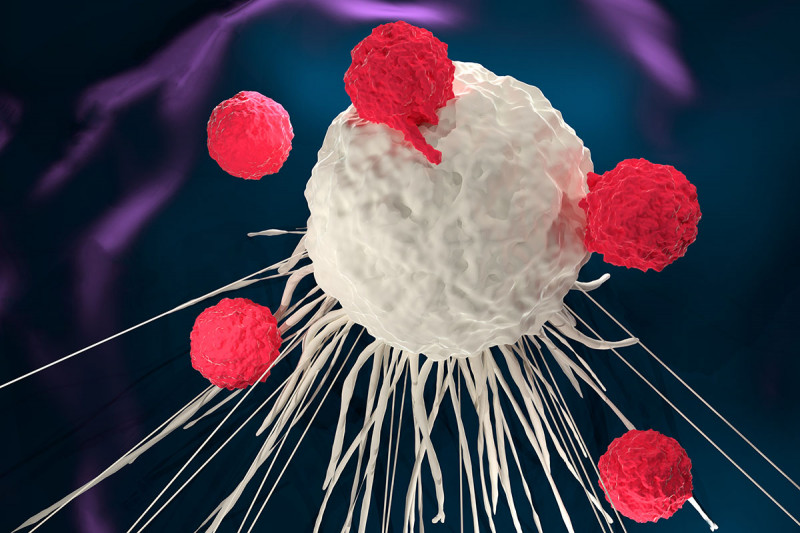
Immune T cells (pink) surround and attack a cancer cell (white).
The 2018 Nobel Prize in Physiology or Medicine went to the scientific minds behind checkpoint blockade immunotherapy. The approach has produced striking results in some people with advanced cancer. It has been likened to taking the brakes off immune cells, freeing them to fight the disease.
Unfortunately, checkpoint blockade works for only a fraction of those who receive it, raising the question of why.
On June 17, a trio of papers published in Nature shed light on what makes an immune cell a good cancer killer or a lame duck assassin. All of the papers deal with a protein called TOX.
Andrea Schietinger, an immunologist at the Sloan Kettering Institute, is the corresponding author on one of the papers. Her team looked at TOX in the context of cancer and chronic infections. They found that TOX is particularly abundant in T cells that have become dysfunctional, or exhausted.
“Exhausted T cells do not kill cancer cells, and they also make lots of braking molecules, such as PD-1,” Dr. Schietinger says. “This led us to wonder whether getting rid of TOX would remove these brakes and make T cells better cancer killers.”
To the investigators’ surprise, they found that T cells lacking TOX did not become more effective killers. In fact, the longer they went without TOX, the more likely they were to die. The results have implications for how doctors and researchers think about immunotherapy for cancer.
Searching for a Cause of Dysfunction
Previous studies from the Schietinger lab have shown that dysfunctional T cells express a pattern of genes that’s different from what is found in functional T cells. They wanted to know what was responsible for this difference, so they went in search of genes that might act as control switches. They homed in one gene, TOX, whose expression was particularly ramped up in dysfunctional T cells compared with functional T cells.
In mice, TOX expression goes up the longer T cells are exposed to a target — be it a virus or a cancer cell. In tandem, this chronic stimulation leads the T cells to become exhausted and dysfunctional.
What about in humans? With the help of Memorial Sloan Kettering doctors, the team looked at TOX levels in T cells obtained from people with cancer. Sure enough, exhausted T cells taken from people with melanoma, breast cancer, lung cancer, and ovarian cancer had high levels of the TOX protein.
Dr. Schietinger and colleagues — including Andrew Scott, a Weill Cornell graduate student, and Mary Philip, a former postdoc who is now a faculty member at Vanderbilt University — wanted to know what exactly TOX was doing in the T cells, so they did two things. First, they made normal T cells overexpress the TOX gene. When they did this, they found that the cells increased their production of braking molecules, like PD-1. In a second experiment, they knocked out the TOX gene so it was missing from the cells. In this case, the cells did not make any of the braking molecules. To the researchers, these results suggested that the TOX protein is a master switch for these brakes.
An Immunological Safety Net
Next they put T cells lacking TOX into a mouse model of cancer and followed the cells over time in tumors. To the team’s surprise, the T cells lacking TOX began to die as the tumors grew. This led the researchers to a startling conclusion: “The brakes are there for a reason — to prevent the cells from getting overstimulated and dying,” Dr. Schietinger says.
Another surprising finding was that even without any brakes, at no point were the TOX-less T cells better killers. To Dr. Schietinger, these counterintuitive results suggest that a T cell’s “kill program” is uncoupled from its braking system. This could explain why drugs that affect the braking system don’t always lead to effective cancer treatment.
Rather than focus solely on lifting the brakes, she says, researchers need to “get to the bottom of T cell dysfunction and find ways to prevent or undo it.”




